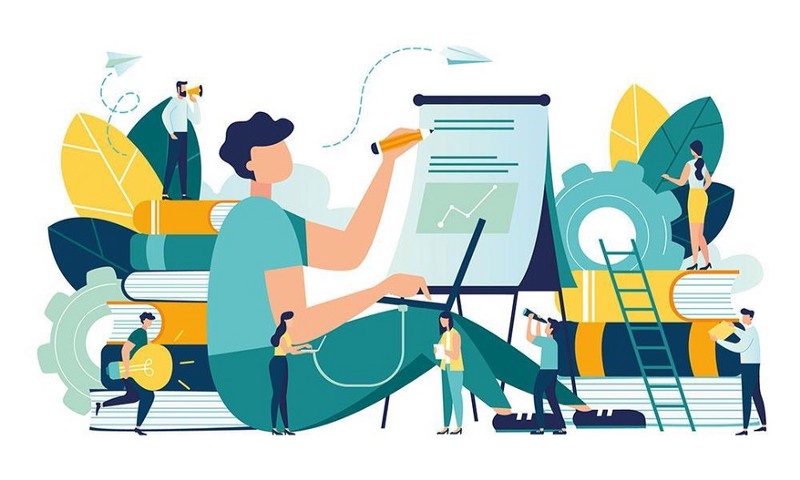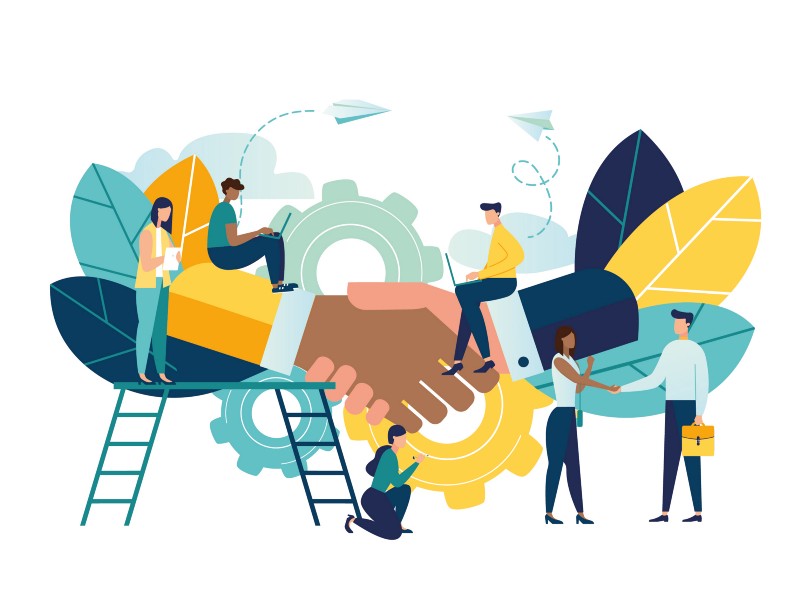
DesignBetter Illustration by InVision, showing design leadership
In my first story ‘User Experience is …’ I promised that …
"over the course of a few stories, I’ll try and cover a few of the sciences we draw upon in our art as a creative community to create engaging experiences."
And in one of early stories I talked around how important it is that User Experience is … User Research. I wanted to build on that, this time out and develop a slightly different mindset to user research.

DesignBetter Illustration by InVision, showing design leadership
Previously I’ve talked around the many hats that user experience designers need to transition across in order to deliver successful products. I’ve also talked about what it takes to be a product leaders.
This time around I’m going to talk about what it takes to be a (design) leader. The reason for the brackets is this is a transferable approach across most disciplines. I’ll only be able to scratch the surface, but this might be a topic I come back to.
Everyone is able to be a leader, it’s not something you have to be given in a job title, but it’s a different mindset and approach to take. Fair enough management might not be for everyone, but everyone should be able to become a leader in some way. So whether you’re focussed on your own individual contribution to design, the design of a product or design within an organisation. Or you’re looking to transition from being an individual contributor to become more of a manager of a design team. Showing leadership is about the decisions you make and how other people see you. It’s about how you do things not necessarily what you do.
It’s a bit of a cliche I know. So if everyone can be a leader, what does it take to be a leader?! Here’s some insights I’ve gathered from the (sometimes painful) lessons design leaders and designers have shared with me about their teams.
These can be applied to either an individual contributor or the management of a design team. Often the UX designer either supports or plays a key role within teams, as they are able to distill ideas for teams to centre around. And if done well they can explore and articulate the key value of the outcomes within products.

A team is more than just a group of individuals
Whether your team’s colocated or distributed, as a leader you’re the glue that holds the team together. That doesn’t mean that you always have to instigate opportunities for the team to get together. But the team may look to you for guidance when trying to gather the team or if there are conflicts in priority between team time and product time. Within distributed teams, time to get together might need to happen a little more often and less organic, so that the team stay feeling connected.
They will look to you to provide a framework for opportunities for the team to get together. This could be using lean coffee on a semi frequent basis, so the team is able to check in with each other and talk about things that are important to them. Or it could be the team want the opportunity to spend more time together to work through something particularly challenging or exploring how they could work better together.
You may need to foster and facilitate team meetings most of the time, even if your team is self-organising and someone else organises them. This will maintain the attendance and importance of the occasions your team uses to get together. As after all if you’re not there what’s the point of everyone else turning up?

You’re the conductor, you orchestrate the team’s rhythm, as a centre piece to the team.
Along with creating a framework for the team to get together, you’ll need to foster an environment that encourages healthy feedback and collaboration. Design does not happen in a bubble. Establishing a team rhythm and work patterns, will aid productivity and team harmony, so that people can make themselves available to share works-in-progress or collaborate to solve a problem. The conductor’s job is to take a group of individuals and get them to work together as a team, in harmony and within the same rhythm.

Building and growing your team
It’s difficult to transition into a leadership role, as your talents of an individual contributor don’t necessarily translate into management skills. And to be honest you don’t know what’s around the corner and what the next situation is that you’re going to have to deal with, so you’re never going to be 100% prepared to be a design leader, but if you’re always 100% committed, your team will have your back.
So while the journey from designer to leader might not be easy, if you have a strong team ethic that will be a good guide to cultivate an entirely new set of skills, including how to:
As a design leader, you’ll have a lot on your plate! Let’s take a look at one of the most important jobs; how to build your team.

Shared values and culture help build stronger teams
Your team is unlike any other team in your company — though your team is part of the broader company culture, you have your own sub-culture, too. The act of design is uniquely emotional, as it requires exploration of new and uncharted territory.
Because design is often a qualitative endeavour — operating on feel, not numbers — it introduces a level of vulnerability that is atypical of product management or engineering. It is a unique discipline with its own set of values.
And those values are important. They will shape your culture, hiring decisions, team member evaluations, productivity, and ultimately the happiness of each person on your team.
As a design leader, one of the first steps you should take is to work with your team to define the core values that will shape your culture and establish a motivational foundation for the work you do. When there’s buy-in from everybody, teams operate more cohesively.

And it’s not just your team, you’ll have to work across many teams
Great design leaders recognise that their team’s work is but one piece of the broader ecosystem of their organisation. Engineering, product management, research, support, and many other teams play important roles in creating a great user experience. You’ll need to build social capital across your organisation by developing a rapport with your colleagues.
Get in the habit of stepping away from your computer to get to know people. Grab lunch with a developer who may build out your team’s next design. No need for an agenda — just get to know each other. Spend time with researchers who have their finger on the pulse of your customers and sales people who have frequent “face time” with customers.
As Mark Opland, Design Manager at Facebook said, “Your legs are your most effective design tool. Get out and connect with people.”

Building a good network and partnerships
“First and foremost, a design leader needs to be empathetic, driven by curiosity to observe people beyond just dialogue,”
“This will support design leaders to better understand the needs of customers to initiate relevant innovations, drive great design leadership amongst their creative talent, and enable cross-functional collaboration with colleagues.”
Eriq Quint, Vice President and Chief Design Officer at 3M.”
So there’s a few things that might help to transition into a leadership role from an individual contributor. If you’re interested to learn more than take a look at these articles from some top people and companies.
How to manage a design team | Inside Design Blog
Great managers are not bosses-they're servant leaders who wield their power to help others do their best work ...
Design leaders from Airbnb, Google, and Wall Street Journal on inclusivity, impact, and measuring
We wrapped up the third season of our Design Better Podcast last month, where we explored the connected workflow ...
What design leadership means to Accenture's Christina Goldschmidt | Inside Design Blog
Christina Goldschmidt is a digital strategist and design leader working in management consulting for Bloom, a new ...
Interview with design sprint inventor and author of "Make Time" Jake Knapp
Jake Knapp now thinks "productivity" is a dirty word. Yes, the New York Times best-selling author of has a new ...
I’ve only just managed to scratch the surface here. There is so much more to (design) leadership that no doubt I’ll come back to add to this later. Feel free to read more from the other design leaders and about the other companies above.
Looking at colour theory, has taken me back to looking back at the guiding principals and theories that make up the basics of UX. By way of an intro to the basics of UX, I’m going to look at 7 UX laws that are so good, that people actually put their names to them!
Originally written as part of the ‘User Experience is …’ series for UX Collective.